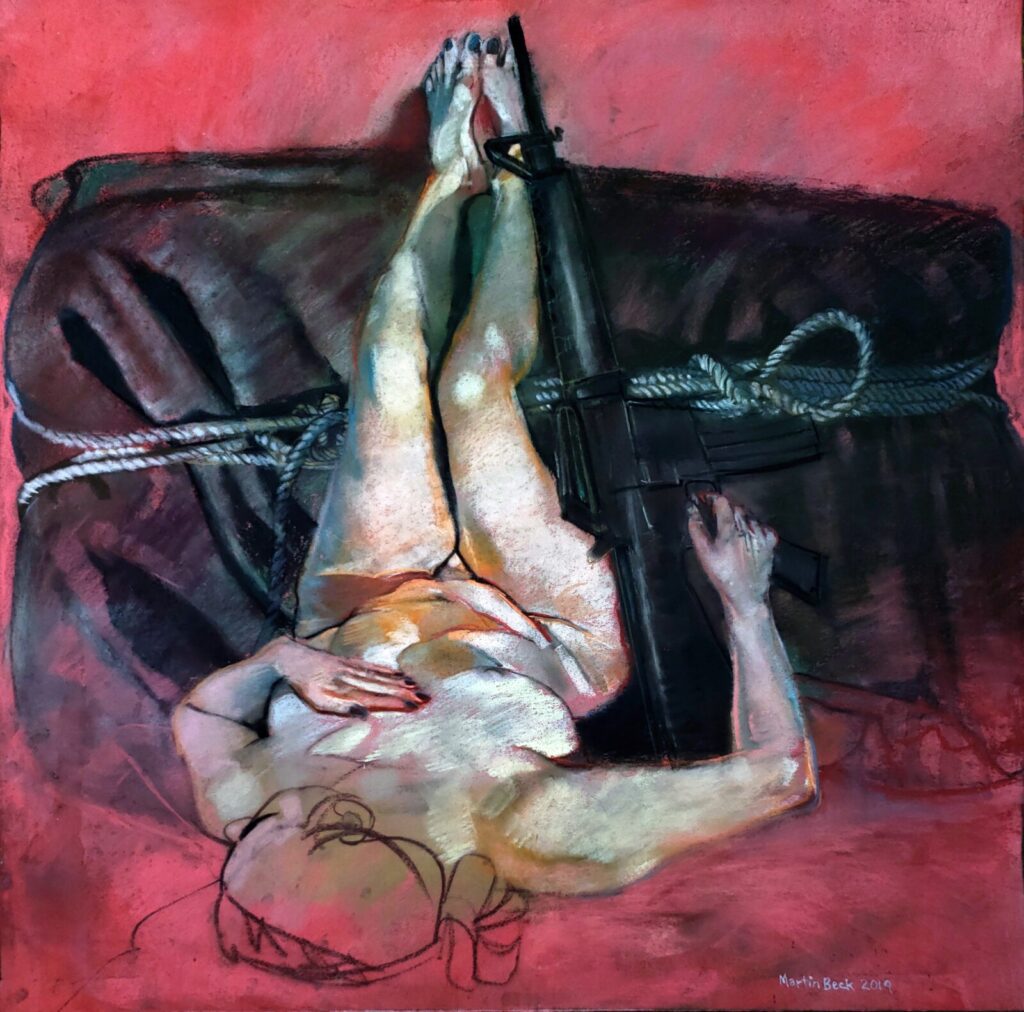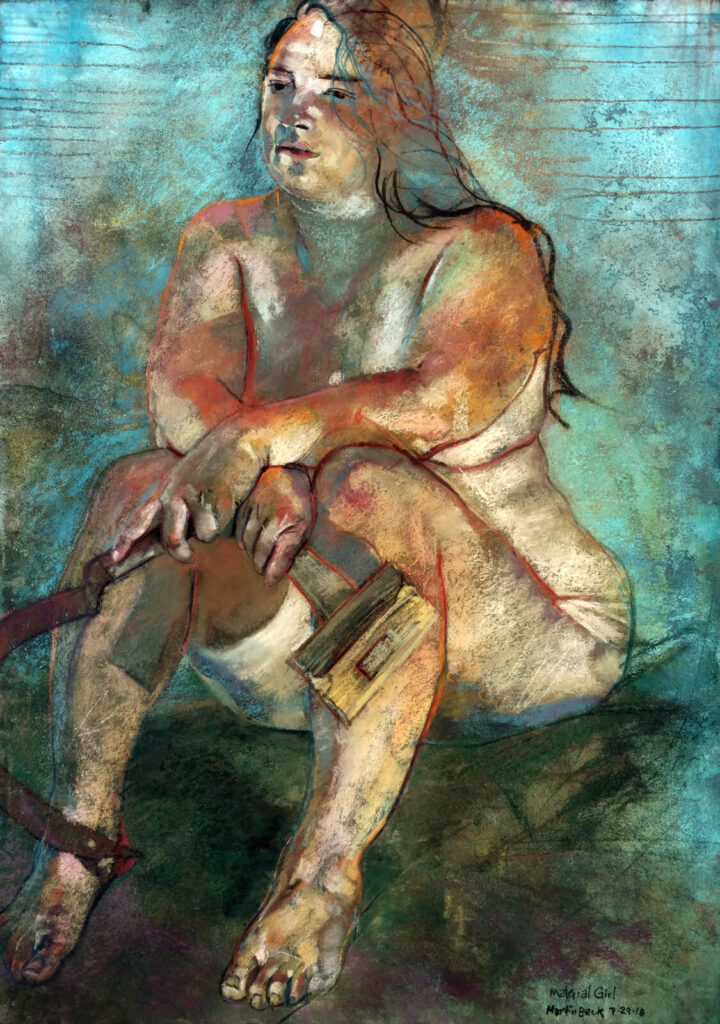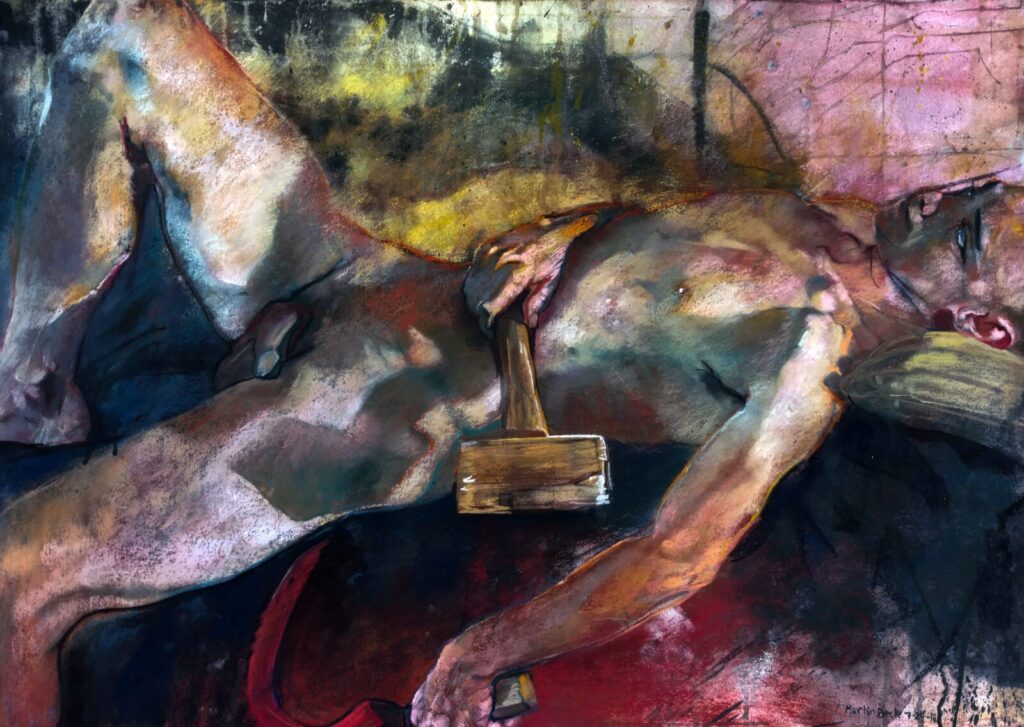By nature, a palimpsest is a document that collapses time, bringing together two disparate moments juxtaposed one over the other. It is this temporal slippage that is at the center of Martin Beck’s current exhibition on view at MS Rezny in Lexington. Beck’s works function as the titular palimpsest (or Palimpsest 2 in this particular case) by drawing on the historicity associated with the nude in Western art history—both with regard to the long tradition of the nude dating back to antiquity and in terms of its usage in order to create a sense of the past by removing the sartorial markers of a present moment—while simultaneously imbuing the works with an undeniable sense of the here and now.
Taken from life, Beck’s figures contain a certain phenomenological quality that makes them undeniably present, particularly through the tactility of his chosen medium. Moreover, his drawings engage with the present through the inclusion of subtle and simple symbolic objects—including guns and even the hammer and sickle—that remind us of the highly contentious and politicized climate of our current moment. In so doing, Beck draws the viewer into a moment of deep contemplation of the conditions of their present state, both in front of the work and in our society on the whole.

For all of the works in Palimpsest 2, Beck manages to blur the line between eternal and ephemeral. On the one hand, works like Tuesday engage with the long tradition of the nudes within the western canon. In this work, a young woman appears seated, legs stretched out in front of her as centuries of reclining female nudes have done before. Beck further gives her a sense of timelessness by rendering the setting completely illegible. Abstract coloration has taken the place of any scenery, including whatever implement she is seated upon, providing the viewer with no historical content to understand this appearance. With no such temporal signifiers, we are left with an eternal nude.
At the same time, this eternal quality is undercut by the tactility of the work and the fact that it is drawn from life. While Beck uses a variety of media in creating his drawings, the works are all clearly marked by the hand of the artist in the present moment rendering them not only visually compelling, but also imbuing them with a haptic quality. The gradations in texture and color as well as the clear imprints of the hand used to contour and shade all provide the work with a sense of immediacy and the momentary.
While the subject matter may feel eternal, the works are undeniably the result of an instantaneous and particular interaction. This momentary quality is furthered by the fact that all of the works are drawn directly from life. According to Beck, “working from life, the model and artist reveal the truth of a specific time, place and act. […] Rather than think of these as pictures of people, for me these are authentic depictions of selective experiences.†As such, Beck’s nudes are given an ephemerality and a temporality of the present, despite the lack of signifiers that would tie them to a time or place.

Yet not all of Beck’s works involve the complete disavowal of present-day objects in order to create this collapsing of time within each one. Some works, like the piece Ties that Bind, include clear references to our current moment in the form of specific items, while still maintaining a sense of temporal ambiguity. In this piece, Beck depicts a woman lying on the ground, with her head at the bottom of the composition and her legs propped up on some unknown, wrapped object, holding an assault rifle next to her right hip. Beck unsettles the woman from time and space, not only through her nudity, but again through his abstraction of the background; Beck denies the viewer a concrete horizon line and thus she appears floating and timeless.
At the same time, Beck’s inclusion of the gun works to draw us immediately back to the present. Given the prevalence of gun violence—especially that carried out with assault-style weapons—it is impossible to view the rifle by her side and not consider both the carnage and the contention surrounding these objects in our current moment. As such, Beck uses these objects to further the sense of the present within each work.


While some of the items included in Beck’s images are unabashed signifiers of our present moment, others have a subtler allusion to temporal “now.†For instance, several of the works, including Material Girl, Lurid Red, and Home Grown #4, all involve nude figures—a singular woman in the cases of Material Girl and Lurid Red and a man for Home Grown #4—holding a hammer and sickle. Unlike the assault rifle, the signification of these objects is less immediate; in the almost three decades since the decline of the Soviet Union, the hammer and sickle have become more historic signifiers than anything else.
Yet Beck’s inclusion of these object in works that—which through their tactility involve a sense of immediacy and the present—functions to dust off the historical characteristic of the hammer and sickle and force us to examine their role in the present. Given the current contentious geopolitical situation between the United States and Russia, and the outspoken desire of Russia’s president to return to the glory days of the U.S.S.R., these seemingly outdated objects do have a clear bearing on our contemporary existence.
Furthermore, the continued debates over “Socialism†and its place within the United States is also evoked, albeit not answered, through Beck’s inclusion of these items. In considering his works with regard to the palimpsest, this inclusion lays bare the fact that the same object or text can participate in different discussions at separate moments overtime, wherein traces of the past engage in dialogue withnew iterations in the present.
Moreover, in addition to the multiple temporalities at play in each work, the show evokes the sense of the palimpsest for which it is named when viewing the works in a conglomeration. As documents, palimpsests are multifaceted and often layered works, with newer text interspersed amongst the older. The result is a document that requires both close reading and a sense of distance in order to fully ascertain its full meaning. This oscillation between proximal and detached viewing is underscored in the way the exhibition is curated. Beck’s works adorn not only the surrounding walls of the gallery, but also a smaller, four-sided pilaster and both sides of a false wall.
These two structures divide the gallery so that only some of the works can be viewed from a single, distanced vantage point. Moreover, the placement of the pilaster requires us to get close to the images, and to even be surrounded by them. In so doing, we engage each image, phenomenologically speaking, with a close intimacy of the present while simultaneously being made aware of a larger continuum within the body of work, much as we would while actually reading a palimpsest.
On the whole, Martin Beck’s latest works call our attention to the present and its position within a larger temporal trajectory. The tactility of his medium and his use of live drawing bring us, the audience, into a particular ephemeral and instantaneous moment, while his subject matter—the nude—calls our attention to a longer tradition of history. Similarly, Beck’s use of abstract backgrounds works to remove us from a specific temporality, while the objects he often presents alongside his figures draw us back into our contemporary settings. Beck’s work thus demands both proximity and distance, presence and detachment, from his viewers, creating a layered and multifaceted experience.




